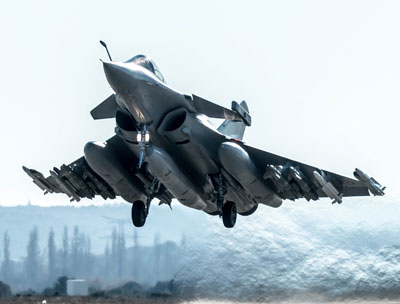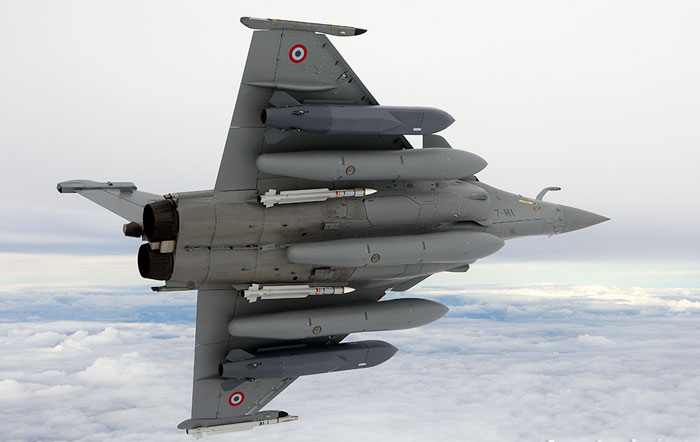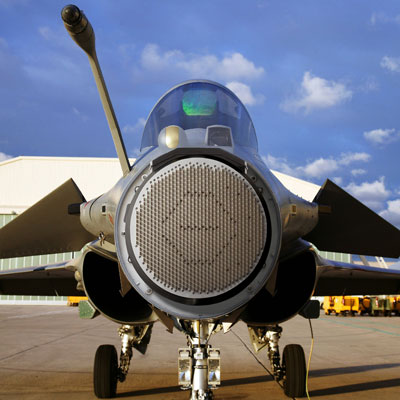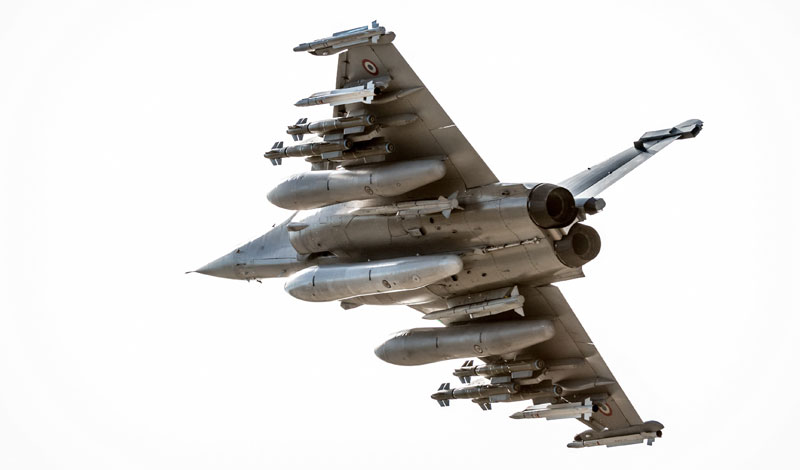
This
preliminary work, self-funded by Dassault Aviation’s are conducted in
collaboration with the DGA and will eventually lead to a complete
clearance of the flight envelope. Photo: Dassault Aviation
At present, the French military remains the single user of this impressive, but controversial jet fighter, since it failed each and every competition except the largest, most lucrative one – the MMRCA competition in India. But Dassault can’t cash in this win, since even after two years of negotiations the contract with the Indian government hasn’t been signed. The Rafale won that competition after it was selected ‘the lowest bidder’, against the Eurofighter Typhoon. But since its selection its cost escalated sharply and almost doubled, bringing the Indian government, currently heading for election, to develop cold feet about their decision to favor the French fighter.
Nevertheless, Dassault is committed to bring new capabilities to the Rafale, according to plan, upgrading the aircraft to the Rafale F3-R standard by 2018. These initial tst flights were only the first in a long series, additional test flights are planned to a complete the clearance of the flight envelope for this configuration, providing the Rafale full multi-role capability at extended range.
Equipped with this configuration, two Rafale aircraft represent the same potential as six Mirage 2000 class aircraftThis configuration comprise a full increment of six air-to-air and six air-to-ground weapons. The air-to-ground ordnance includes six Sagem/MBDA Hammer guided weapons (AASM), carried on two triple-ejector racks, designed specifically for the weapon. The AASM is deployed with one of three optional guidance methods utilizing a GPS guided, laser homing or thermally guided seekers. To extend its range the Hammer is also equipped with a rocket booster. Four MICA air-to-air missiles and two very long range Meteor missiles will be complementing the fighter’s air-to-air capability. The MICA missiles are operational and can be employed with IR or radar guided. These Meteor missiles are yet to enter service – but they are expected to be fielded with the F3-R variant by 2018. In addition to that impressive weapons complement, Rafale will retain its Nexter 30M791 30 mm internal cannon, firing 2500 rounds/min. According to the manufacturer, equipped with this configuration, two Rafale aircraft represent the same potential as six Mirage 2000 class aircraft.
Since June 2013 all production aircraft configured to the new F3-04T-standard are equipped with the new radar, along with an improved front sector optronics equipment (also from Thales) and the DDM-NG passive missile approach warning system, produced by MBDA.The weapons would take less than a third of the fighter’s payload – the rest will be used to carry fuel to sustain the long range missions the fighter is required to perform. The Rafale can carry up to 9.5 tons of payload (21,000 lbs). To support missions at extended ranges the fighter also carries three 524 gallons (2,000 litre) fuel tanks weighing additional 6.7 tons (14,700 lbs) that will top up the fighter’s internal fuel capacity of 4.7 t (10,300 lbs). These fuel tanks can also be used for ‘buddy refuelling’, further increasing the range and mission endurance of a Rafale-based strike force, a capability particularly important for the naval strike missions.

In
the current configuration Rafale carries two Scalp cruise missiles or
four direct attack weapons (Hammer/laser guided bombs), with four MICA
air-to-air missiles. Photo: French Air Force

Rafale
No. 137 was the first to be equipped with Thales’ new RBE2 AESA radar
and the new Front Section Optronics Optronic (FSO-IT) suit. Photo:
Dassault Aviation
The Rafale entered service with the French Navy in 2004 and with the French Air Force in 2006. Of the 180 aircraft ordered by France to date, 126 have been delivered. India has also selected the Rafale for its Medium Multi Mission Combat Aircraft (MMRCA) requirement, planning to order at least 126 of the jet fighters. However, two years after the selection New Delhi has not finalized the contract with Dassault and, pressed by the upcoming elections, the Indians are considering a limited order of 18 aircraft to be produced in France, as a near-term solution to get the deal in motion.
The defence ministry headed by AK Antony has developed cold feet after the cost doubled compared to the original estimate. With the general elections just months away, Antony is unsure about the fate of the deal, a defence ministry official said. India’s Diligent Media Corporation (DNA) reports. In January 2012, when Rafale was declared the winner, its price was quoted between $60-65 million (Rs373-Rs400 crore). Today, according to the , its price could now soar to $120 million (Rs746 crore). The second bidder, Eurofighter, had quoted $80-85 million (Rs497-Rs528 crore). The price hike would mean that the deal would cost India nothing less than $28-30 billion (Rs1.75 lakh crore-Rs1.86 lakh crore) DNA quoted an anonymous Indian Air Force source close to the negotiation committee. In 2007, when the tender was floated, the cost of the programme was $12 billion (Rs42,000 crore). When the lowest bidder was declared in January 2012, the cost of the deal shot up to $18 billion (Rs90,000 crore).
The Rafale fleet with the French Air Force and Navy currently totals almost 120,000 flight hours, including 16,000 in operations. Since mid-2013, production Rafale aircraft are equipped with an active array RBE2 AESA radar from Thales.
Expected to become operational in 2018, Rafale F3-R will be an evolutionary upgrade of the current F3 variant, a part of an ongoing enhancement of the French fighter. Among the improvements are the introduction of RBE2 active electronically scanned array (AESA) radar, developed by Thales. This radar has already been fielded with at least 60 of the Rafales. The first to get the new radar was aircraft #137, that rolled of the production line in October 2012.
Since mid 2013 production aircraft are configured to the new F3-04T-standard are equipped with the new radar, along with an improved front sector optronics (FSO-IT) equipment (also from Thales) and the DDM-NG passive missile approach warning system, produced by MBDA. Another new capability to be integrated with the fighter by 2018 will be the PDL-NG new-generation laser designation pod, currently under development at Thales. Other planned sensors upgrades related to air-to-surface capabilities include assisted target recognition and enhanced sensor resolution, enabling the Rafale to attack ever more elusive targets.
According to Dassault, the ongoing effort will ensure more robust detection, tracking and identification of emerging air-to-air threats, and increase the Rafale’s survivability with new low observable modes and with the latest advances in electronic warfare systems.

The
Rafale has successfully completed its first test flights in a new
heavily-armed configuration, comprising six air-to-ground precision AASM
Hammer missiles, four medium and long range air-to-air missiles from
the MICA family, two very long range METEOR missiles, as well as three
2,000 liter fuel tanks. Photo: Dassault Aviation
No comments:
Post a Comment